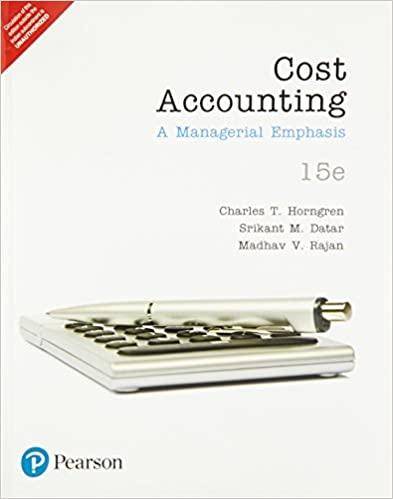Answered step by step
Verified Expert Solution
Question
1 Approved Answer
(please it doesn't matter if it's takes more than a 2 to 5days before you answer it.) Improving Accounts Payable at Hilliard Manufacturing Introduction Abigail

(please it doesn't matter if it's takes more than a 2 to 5days before you answer it.)
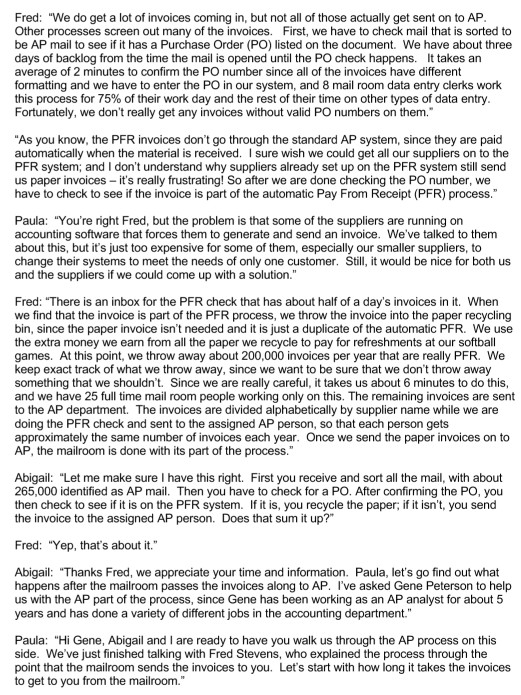
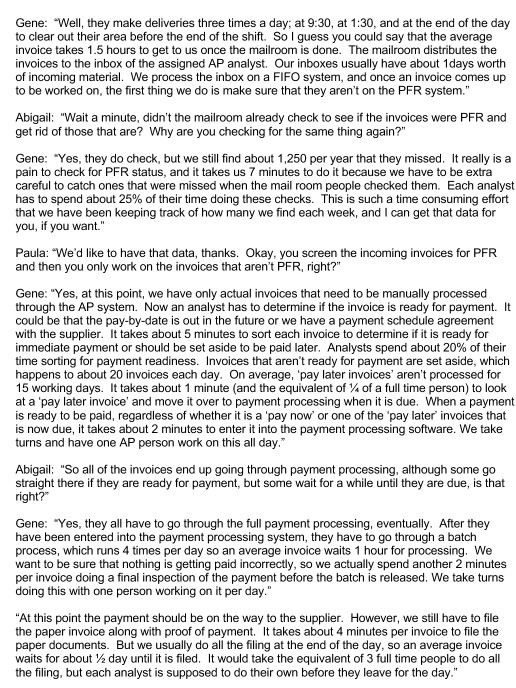
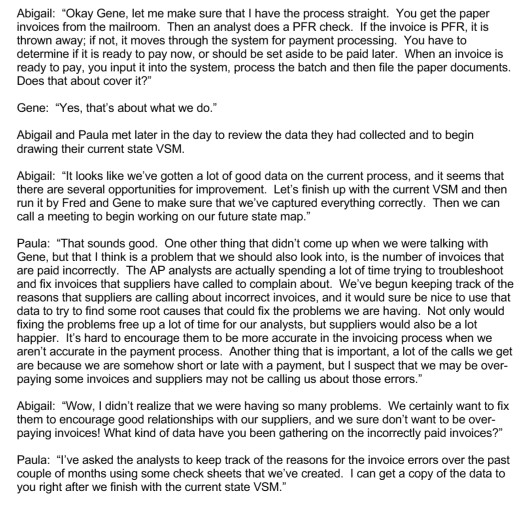
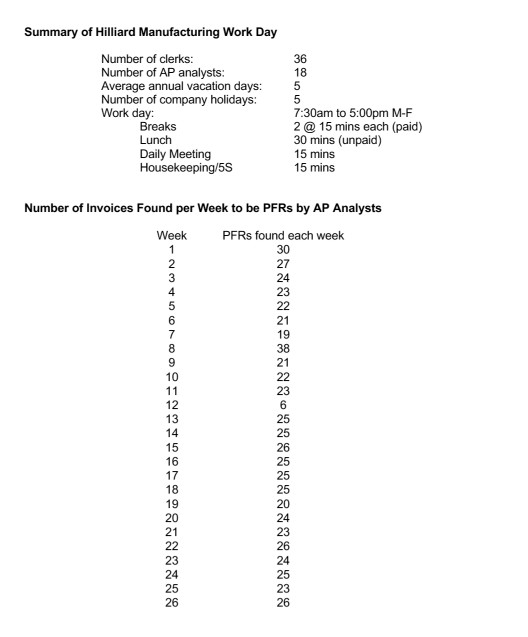
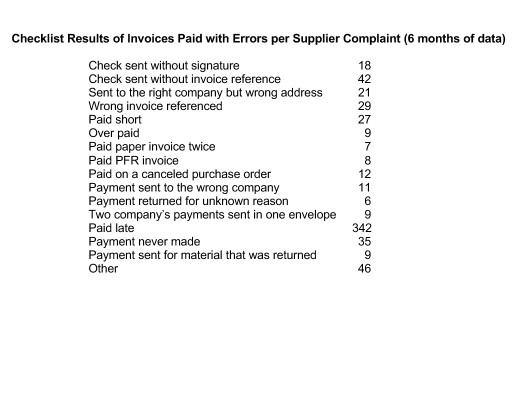
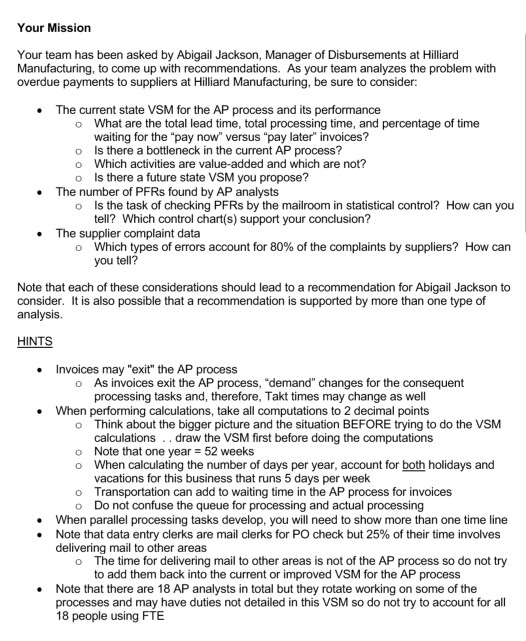
Improving Accounts Payable at Hilliard Manufacturing Introduction Abigail Jackson, Manager of Disbursements at Hilliard Manufacturing thought to herself Just a few more days until the Kaizen event kicks off" As Manager of Disbursements, Abigail oversaw four departments in accounting: the Sales and Use Tax Department: the Payroll, Time and Expense Reporting Department the Accounts Payable Department and the International Accounting Department Hilliard Manufacturing's new CEO, Al Cooper, had developed and championed Hilliard Manufacturing's new Lean Initiative not long after taking over. After achieving substantial improvements in cost, lead time and quality from the application of lean principles on the manufacturing floor, Al fel it was time to apply the same principles to other functional areas. Given the importance of Accounts Payable (AP) in maintaining a smooth flow of incoming material and preserving good relationships with suppliers, Al felt that the AP area been experiencing increasing lead times for invoice payment, would be a good place to start , which had With the top management directive of working on improvements in the AP process, Pat Davis, the Assistant Controller and Abigail's boss, scheduled a meeting to review the current situation Just look at this" Pat said while pointing to a column of numbers in a spreadsheet. "We've got almost 6.5% of our accounts payable overdue, and our suppliers are not happy about it! In a few cases, it's even impacting further shipments of parts, potentially causing our manufacturing plant to miss shipping due dates and impacting customers. We must get a handle on this!" Walking the Process Following that meeting, Abigail met with Paula Martin, Manager of the Accounts Payable Department, to better understand the entire AP process. Paula provided a good overview of how the process should work, but Abigail realized that she would need to walk the process herself to truly understand the current state of things. She scheduled a walk-through of both the mailroom and the AP Department, armed with a clipboard, stopwatch, calculator, paper, and pencil to create a formal current state value stream map (VSM) The AP process begins at the mailroom which processes incoming mail from all sources uding invoices from suppliers. Once there, Paula and Abigail spoke with Fred Stevens, the Mailroom Manager Fred explained the process to Abigail: "We've noticed, based on the post mark of incoming mail that it takes about 7 days for most mail to get to us. After the mail is received, it has to be opened and sorted. We are running a bit behind, so we usually open the mail two days after we get it. If it doesn't belong to AP we have to route it to the right department. We receive about 300,000 pieces of mail each year. It takes about 1 minute to open and look at each piece of mail, to determine if it is AP mail. We find that about 35,000 pieces a year do not belong to AP Abigail: "Wow, I didn't realize so many invoices came in each year. I thought that we had an automatic payment process that was supposed to reduce incoming invoices Fred: "We do get a lot of invoices coming in, but not all of those actually get sent on to AP Other processes screen out many of the invoices. First, we have to check mail that is sorted to be AP mail to see if it has a Purchase Order (PO) listed on the document. We have about three days of backlog from the time the mail is opened until the PO check happens. It takes an average of 2 minutes to confirm the PO number since all of the invoices have different formatting and we have to enter the PO in our system, and 8 mail room data entry clerks work this process for 75% of their work day and the rest of their time on other types of data entry Fortunately, we don't really get any invoices without valid PO numbers on them. As you know, the PFR invoices don't go through the standard AP system, since they are paid automatically when the material is received. I sure wish we could get all our suppliers on to the PFR system; and I don't understand why suppliers already set up on the PFR system still send us paper invoices- it's really frustrating! So after we are done checking the PO number, we have to check to see if the invoice is part of the automatic Pay From Receipt (PFR) process Paula: "You're right Fred, but the problem is that some of the suppliers are running on accounting software that forces them to generate and send an invoice. We've talked to them about this, but it's just too expensive for some of them, especially our smaller suppliers, to change their systems to meet the needs of only one customer. Still, it would be nice for both us and the suppliers if we could come up with a solution Fred: "There is an inbox for the PFR check that has about half of a day's invoices in it. When we find that the invoice is part of the PFR process, we throw the invoice into the paper recycling bin, since the paper invoice isn't needed and it is just a duplicate of the automatic PFR. We use the extra money we earn from all the paper we recycle to pay for refreshments at our softball games. At this point, we throw away about 200,000 invoices per year that are really PFR. We keep exact track of what we throw away, since we want to be sure that we don't throw away something that we shouldn't. Since we are really careful, it takes us about 6 minutes to do this, and we have 25 full time mail room people working only on this. The remaining invoices are sent to the AP department. The invoices are divided alphabetically by supplier name while we are doing the PFR check and sent to the assigned AP person, so that each person gets approximately the same number of invoices each year. Once we send the paper invoices on to AP, the mailroom is done with its part of the process Abigail: "Let me make sure I have this right. First you receive and sort all the mail, with about 265,000 identified as AP mail. Then you have to check for a PO. After confirming the PO, you then check to see if it is on the PFR system. If it is, you recycle the paper; if it isn't, you send the invoice to the assigned AP person. Does that sum it up?" Fred: "Yep, that's about it." Abigai: "Thanks Fred, we appreciate your time and information. Paula, let's go find out what happens after the mailroom passes the invoices along to AP. I've asked Gene Peterson to help th the AP part of the process, since Gene has been working as an AP analyst for about 5 years and has done a variety of different jobs in the accounting department. Paula: "Hi Gene, Abigail and I are ready to have you walk us through the AP process on this side. We've just finished talking with Fred Stevens, who explained the process through the point that the mailroom sends the invoices to you. Let's start with how long it takes the i to get to you from the mailroonm Gene: "Well, they make deliveries three times a day; at 9:30, at 1:30, and at the end of the day to clear out their area before the end of the shift. So l guess you could say that the average invoice takes 1.5 hours to get to us once the mailroom is done. The mailroom distributes the invoices to the inbox of the assigned AP analyst. Our inboxes usually have about 1days worth of incoming material. We process the inbox on a FIFO system, and once an invoice comes up to be worked on, the first thing we do is make sure that they aren't on the PFR system. Abigail: "Wait a minute, didn't the mailroom already check to see if the invoices were PFR and get rid of those that are? Why are you checking for the same thing again?" Gene: "Yes, they do check, but we still find about 1,250 per year that they missed. It really is a pain to check for PFR status, and it takes us 7 minutes to do it because we have to be extra careful to catch ones that were missed when the mail room people checked them. Each analyst has to spend about 25% of their time doing these checks. This is such a time consuming effort that we have been keeping track of how many we find each week, and I can get that data for you, if you want." Paula: "We'd like to have that data, thanks. Okay, you screen the incoming invoices for PFR and then you only work on the invoices that aren't PFR, right?" Gene: "Yes, at this point, we have only actual invoices that need to be manually processed through the AP system. Now an analyst has to determine if the invoice is ready for payment. It could be that the pay-by-date is out in the future or we have a payment schedule agreement with the supplier. It takes about 5 minutes to sort each invoice to determine if it is ready for immediate payment or should be set aside to be paid later. Analysts spend about 20% of their time sorting for payment readiness. Invoices that aren't ready for payment are set aside, which happens to about 20 invoices each day. On average, 'pay later invoices' aren't processed for 15 working days. takes about 1 minute (and the equivalent of 4 of a full time person) to look at a pay later invoice and move it over to payment processing when it is due. When a payment is ready to be paid, regardless of whether it is apay now, or one of the 'pay later invoices that is now due, it takes about 2 minutes to enter it into the payment processing software. We take turns and have one AP person work on this all day. Abigail: "So all of the invoices end up going through payment processing, although some go straight there if they are ready for payment, but some wait for a while until they are due, is that right? Gene: "Yes, they all have to go through the full payment processing, eventually. After they have been entered into the payment processing system, they have to go through a batch process, which runs 4 times per day so an average invoice waits 1 hour for processing. We want to be sure that nothing is getting paid incorrectly, so we actually spend another 2 minutes per invoice doing a final inspection of the payment before the batch is released. We take turns doing this with one person working on it per day." "At this point the payment should be on the way to the supplier. However, we still have to file the paper invoice along with proof of payment. t takes about 4 minutes per invoice to file the paper documents. But we usually do all the filing at the end of the day, so an average invoice waits for about day until it is filed. It would take the equivalent of 3 full time people to do all the filing, but each analyst is supposed to do their own before they leave for the day." Abigail: Okay Gene, let me make sure that I have the process straight. You get the paper invoices from the mailroom. Then an analyst does a PFR check. If the invoice is PFR, it is thrown away; if not, it moves through the system for payment processing. You have to determine if it is ready to pay now, or should be set aside to be paid later. When an invoice i ready to pay, you input it into the system, process the batch and then file the paper documents Does that about cover it? Gene: "Yes, that's about what we do Abigail and Paula met later in the day to review the data they had collected and to begin drawing their current state VSM Abigail: "It looks like we've gotten a lot of good data on the current process, and it seems that there are several opportunities for improvement. Let's finish up with the current VSM and then run it by Fred and Gene to make sure that we've captured everything correctly. Then we can call a meeting to begin working on our future state map Paula That sounds good. One other thing that didn't come up when we were talking with Gene, but thatI think is a problem that we should also look into, is the number of invoices that are paid incorrectly. The AP analysts are actually spending a lot of time trying to troubleshoot and fix invoices that suppliers have called to complain about. We've begun keeping track of the reasons that suppliers are calling about incorrect invoices, and it would sure be nice to use that data to try to find some root causes that could fix the problems we are having. Not only would fixing the problems free up a lot of time for our analysts, but suppliers would also be a lot happier. It's hard to encourage them to be more accurate in the invoicing process when we aren't accurate in the payment process. Another thing that is important, a lot of the calls we get are because we are somehow short or late with a payment, but I suspect that we may be over paying some invoices and suppliers may not be calling us about those errors Abigail: "Wow, I didn't realize that we were having so many problems. We certainly want to fix them to encourage good relationships with our suppliers, and we sure don't want to be over paying invoices! What kind of data have you been gathering on the incorrectly paid invoices? Paula: "I've asked the analysts to keep track of the reasons for the invoice errors over the past couple of months using some check sheets that we've created. I can get a copy of the data to you right after we finish with the current state VSM Summary of Hilliard Manufacturing Work Day Number of clerks Number of AP analysts: Average annual vacation days: Number of company holidays: Work day: 18 7:30am to 5:00pm M-F 215 mins each (paid) 30 mins (unpaid) 15 mins 15 mins Breaks Daily Meeting Housekeeping/5S Number of Invoices Found per Week to be PFRs by AP Analysts PFRs found each week 27 23 2 4 21 19 21 23 25 25 14 15 16 17 18 25 25 25 20 20 21 23 24 25 25 23 Checklist Results of Invoices Paid with Errors per Supplier Complaint (6 months of data) Check sent without signature Check sent without invoice reference Sent to the right company but wrong address Wrong invoice referenced Paid short Over paid Paid paper invoice twice Paid PFR invoice Paid on a canceled purchase order Payment sent to the wrong company Payment returned for unknown reason Two company's payments sent in Paid late 18 42 29 27 12 one envelope Payment never maaterial that was returned Payment sent for material that was returned 46 Your Mission Your team has been asked by Abigail Jackson, Manager of Disbursements at Hilliard Manufacturing, to come up with recommendations. As your team analyzes the problem with overdue payments to suppliers at Hilliard Manufacturing, be sure to consider: The current state VSM for the AP process and its performance o What are the total lead time, total processing time, and percentage of time waiting for the "pay now" versus "pay later" invoices? o Is there a bottleneck in the current AP process? o Which activities are value-added and which are not? o Is there a future state VSM you propose? The number of PFRs found by AP analysts Is the task of checking PFRs by the mailroom in statistical control? How can you tell? Which control chart(s) support your conclusion? o The supplier complaint data Which types of errors account for 80% of the complaints by suppliers? How can you tell? o Note that each of these considerations should lead to a recommendation for Abigail Jackson to consider. It is also possible that a recommendation is supported by more than one type of analysis. HINTS Invoices may "exit" the AP process As invoices exit the AP process, "demand" changes for the consequent processing tasks and, therefore, Takt times may change as well o When performing calculations, take all computations to 2 decimal points Think about the bigger picture and the situation BEFORE trying to do the VSM calculations. .draw the VSM first before doing the computations Note that one year 52 weeks When calculating the number of days per year, account for both holidays and vacations for this business that runs 5 days per week Transportation can add to waiting time in the AP process for invoices o o o o o Do not confuse the queue for processing and actual processing When parallel processing tasks develop, you will need to show more than one time line Note that data entry clerks are mail clerks for PO check but 25% of their time involves delivering mail to other areas The time for delivering mail to other areas is not of the AP process so do not try to add them back into the current or improved VSM for the AP process o Note that there are 18 AP analysts in total but they rotate working on some of the processes and may have duties not detailed in this VSM so do not try to account for all 18 people using FTE Improving Accounts Payable at Hilliard Manufacturing Introduction Abigail Jackson, Manager of Disbursements at Hilliard Manufacturing thought to herself Just a few more days until the Kaizen event kicks off" As Manager of Disbursements, Abigail oversaw four departments in accounting: the Sales and Use Tax Department: the Payroll, Time and Expense Reporting Department the Accounts Payable Department and the International Accounting Department Hilliard Manufacturing's new CEO, Al Cooper, had developed and championed Hilliard Manufacturing's new Lean Initiative not long after taking over. After achieving substantial improvements in cost, lead time and quality from the application of lean principles on the manufacturing floor, Al fel it was time to apply the same principles to other functional areas. Given the importance of Accounts Payable (AP) in maintaining a smooth flow of incoming material and preserving good relationships with suppliers, Al felt that the AP area been experiencing increasing lead times for invoice payment, would be a good place to start , which had With the top management directive of working on improvements in the AP process, Pat Davis, the Assistant Controller and Abigail's boss, scheduled a meeting to review the current situation Just look at this" Pat said while pointing to a column of numbers in a spreadsheet. "We've got almost 6.5% of our accounts payable overdue, and our suppliers are not happy about it! In a few cases, it's even impacting further shipments of parts, potentially causing our manufacturing plant to miss shipping due dates and impacting customers. We must get a handle on this!" Walking the Process Following that meeting, Abigail met with Paula Martin, Manager of the Accounts Payable Department, to better understand the entire AP process. Paula provided a good overview of how the process should work, but Abigail realized that she would need to walk the process herself to truly understand the current state of things. She scheduled a walk-through of both the mailroom and the AP Department, armed with a clipboard, stopwatch, calculator, paper, and pencil to create a formal current state value stream map (VSM) The AP process begins at the mailroom which processes incoming mail from all sources uding invoices from suppliers. Once there, Paula and Abigail spoke with Fred Stevens, the Mailroom Manager Fred explained the process to Abigail: "We've noticed, based on the post mark of incoming mail that it takes about 7 days for most mail to get to us. After the mail is received, it has to be opened and sorted. We are running a bit behind, so we usually open the mail two days after we get it. If it doesn't belong to AP we have to route it to the right department. We receive about 300,000 pieces of mail each year. It takes about 1 minute to open and look at each piece of mail, to determine if it is AP mail. We find that about 35,000 pieces a year do not belong to AP Abigail: "Wow, I didn't realize so many invoices came in each year. I thought that we had an automatic payment process that was supposed to reduce incoming invoices Fred: "We do get a lot of invoices coming in, but not all of those actually get sent on to AP Other processes screen out many of the invoices. First, we have to check mail that is sorted to be AP mail to see if it has a Purchase Order (PO) listed on the document. We have about three days of backlog from the time the mail is opened until the PO check happens. It takes an average of 2 minutes to confirm the PO number since all of the invoices have different formatting and we have to enter the PO in our system, and 8 mail room data entry clerks work this process for 75% of their work day and the rest of their time on other types of data entry Fortunately, we don't really get any invoices without valid PO numbers on them. As you know, the PFR invoices don't go through the standard AP system, since they are paid automatically when the material is received. I sure wish we could get all our suppliers on to the PFR system; and I don't understand why suppliers already set up on the PFR system still send us paper invoices- it's really frustrating! So after we are done checking the PO number, we have to check to see if the invoice is part of the automatic Pay From Receipt (PFR) process Paula: "You're right Fred, but the problem is that some of the suppliers are running on accounting software that forces them to generate and send an invoice. We've talked to them about this, but it's just too expensive for some of them, especially our smaller suppliers, to change their systems to meet the needs of only one customer. Still, it would be nice for both us and the suppliers if we could come up with a solution Fred: "There is an inbox for the PFR check that has about half of a day's invoices in it. When we find that the invoice is part of the PFR process, we throw the invoice into the paper recycling bin, since the paper invoice isn't needed and it is just a duplicate of the automatic PFR. We use the extra money we earn from all the paper we recycle to pay for refreshments at our softball games. At this point, we throw away about 200,000 invoices per year that are really PFR. We keep exact track of what we throw away, since we want to be sure that we don't throw away something that we shouldn't. Since we are really careful, it takes us about 6 minutes to do this, and we have 25 full time mail room people working only on this. The remaining invoices are sent to the AP department. The invoices are divided alphabetically by supplier name while we are doing the PFR check and sent to the assigned AP person, so that each person gets approximately the same number of invoices each year. Once we send the paper invoices on to AP, the mailroom is done with its part of the process Abigail: "Let me make sure I have this right. First you receive and sort all the mail, with about 265,000 identified as AP mail. Then you have to check for a PO. After confirming the PO, you then check to see if it is on the PFR system. If it is, you recycle the paper; if it isn't, you send the invoice to the assigned AP person. Does that sum it up?" Fred: "Yep, that's about it." Abigai: "Thanks Fred, we appreciate your time and information. Paula, let's go find out what happens after the mailroom passes the invoices along to AP. I've asked Gene Peterson to help th the AP part of the process, since Gene has been working as an AP analyst for about 5 years and has done a variety of different jobs in the accounting department. Paula: "Hi Gene, Abigail and I are ready to have you walk us through the AP process on this side. We've just finished talking with Fred Stevens, who explained the process through the point that the mailroom sends the invoices to you. Let's start with how long it takes the i to get to you from the mailroonm Gene: "Well, they make deliveries three times a day; at 9:30, at 1:30, and at the end of the day to clear out their area before the end of the shift. So l guess you could say that the average invoice takes 1.5 hours to get to us once the mailroom is done. The mailroom distributes the invoices to the inbox of the assigned AP analyst. Our inboxes usually have about 1days worth of incoming material. We process the inbox on a FIFO system, and once an invoice comes up to be worked on, the first thing we do is make sure that they aren't on the PFR system. Abigail: "Wait a minute, didn't the mailroom already check to see if the invoices were PFR and get rid of those that are? Why are you checking for the same thing again?" Gene: "Yes, they do check, but we still find about 1,250 per year that they missed. It really is a pain to check for PFR status, and it takes us 7 minutes to do it because we have to be extra careful to catch ones that were missed when the mail room people checked them. Each analyst has to spend about 25% of their time doing these checks. This is such a time consuming effort that we have been keeping track of how many we find each week, and I can get that data for you, if you want." Paula: "We'd like to have that data, thanks. Okay, you screen the incoming invoices for PFR and then you only work on the invoices that aren't PFR, right?" Gene: "Yes, at this point, we have only actual invoices that need to be manually processed through the AP system. Now an analyst has to determine if the invoice is ready for payment. It could be that the pay-by-date is out in the future or we have a payment schedule agreement with the supplier. It takes about 5 minutes to sort each invoice to determine if it is ready for immediate payment or should be set aside to be paid later. Analysts spend about 20% of their time sorting for payment readiness. Invoices that aren't ready for payment are set aside, which happens to about 20 invoices each day. On average, 'pay later invoices' aren't processed for 15 working days. takes about 1 minute (and the equivalent of 4 of a full time person) to look at a pay later invoice and move it over to payment processing when it is due. When a payment is ready to be paid, regardless of whether it is apay now, or one of the 'pay later invoices that is now due, it takes about 2 minutes to enter it into the payment processing software. We take turns and have one AP person work on this all day. Abigail: "So all of the invoices end up going through payment processing, although some go straight there if they are ready for payment, but some wait for a while until they are due, is that right? Gene: "Yes, they all have to go through the full payment processing, eventually. After they have been entered into the payment processing system, they have to go through a batch process, which runs 4 times per day so an average invoice waits 1 hour for processing. We want to be sure that nothing is getting paid incorrectly, so we actually spend another 2 minutes per invoice doing a final inspection of the payment before the batch is released. We take turns doing this with one person working on it per day." "At this point the payment should be on the way to the supplier. However, we still have to file the paper invoice along with proof of payment. t takes about 4 minutes per invoice to file the paper documents. But we usually do all the filing at the end of the day, so an average invoice waits for about day until it is filed. It would take the equivalent of 3 full time people to do all the filing, but each analyst is supposed to do their own before they leave for the day." Abigail: Okay Gene, let me make sure that I have the process straight. You get the paper invoices from the mailroom. Then an analyst does a PFR check. If the invoice is PFR, it is thrown away; if not, it moves through the system for payment processing. You have to determine if it is ready to pay now, or should be set aside to be paid later. When an invoice i ready to pay, you input it into the system, process the batch and then file the paper documents Does that about cover it? Gene: "Yes, that's about what we do Abigail and Paula met later in the day to review the data they had collected and to begin drawing their current state VSM Abigail: "It looks like we've gotten a lot of good data on the current process, and it seems that there are several opportunities for improvement. Let's finish up with the current VSM and then run it by Fred and Gene to make sure that we've captured everything correctly. Then we can call a meeting to begin working on our future state map Paula That sounds good. One other thing that didn't come up when we were talking with Gene, but thatI think is a problem that we should also look into, is the number of invoices that are paid incorrectly. The AP analysts are actually spending a lot of time trying to troubleshoot and fix invoices that suppliers have called to complain about. We've begun keeping track of the reasons that suppliers are calling about incorrect invoices, and it would sure be nice to use that data to try to find some root causes that could fix the problems we are having. Not only would fixing the problems free up a lot of time for our analysts, but suppliers would also be a lot happier. It's hard to encourage them to be more accurate in the invoicing process when we aren't accurate in the payment process. Another thing that is important, a lot of the calls we get are because we are somehow short or late with a payment, but I suspect that we may be over paying some invoices and suppliers may not be calling us about those errors Abigail: "Wow, I didn't realize that we were having so many problems. We certainly want to fix them to encourage good relationships with our suppliers, and we sure don't want to be over paying invoices! What kind of data have you been gathering on the incorrectly paid invoices? Paula: "I've asked the analysts to keep track of the reasons for the invoice errors over the past couple of months using some check sheets that we've created. I can get a copy of the data to you right after we finish with the current state VSM Summary of Hilliard Manufacturing Work Day Number of clerks Number of AP analysts: Average annual vacation days: Number of company holidays: Work day: 18 7:30am to 5:00pm M-F 215 mins each (paid) 30 mins (unpaid) 15 mins 15 mins Breaks Daily Meeting Housekeeping/5S Number of Invoices Found per Week to be PFRs by AP Analysts PFRs found each week 27 23 2 4 21 19 21 23 25 25 14 15 16 17 18 25 25 25 20 20 21 23 24 25 25 23 Checklist Results of Invoices Paid with Errors per Supplier Complaint (6 months of data) Check sent without signature Check sent without invoice reference Sent to the right company but wrong address Wrong invoice referenced Paid short Over paid Paid paper invoice twice Paid PFR invoice Paid on a canceled purchase order Payment sent to the wrong company Payment returned for unknown reason Two company's payments sent in Paid late 18 42 29 27 12 one envelope Payment never maaterial that was returned Payment sent for material that was returned 46 Your Mission Your team has been asked by Abigail Jackson, Manager of Disbursements at Hilliard Manufacturing, to come up with recommendations. As your team analyzes the problem with overdue payments to suppliers at Hilliard Manufacturing, be sure to consider: The current state VSM for the AP process and its performance o What are the total lead time, total processing time, and percentage of time waiting for the "pay now" versus "pay later" invoices? o Is there a bottleneck in the current AP process? o Which activities are value-added and which are not? o Is there a future state VSM you propose? The number of PFRs found by AP analysts Is the task of checking PFRs by the mailroom in statistical control? How can you tell? Which control chart(s) support your conclusion? o The supplier complaint data Which types of errors account for 80% of the complaints by suppliers? How can you tell? o Note that each of these considerations should lead to a recommendation for Abigail Jackson to consider. It is also possible that a recommendation is supported by more than one type of analysis. HINTS Invoices may "exit" the AP process As invoices exit the AP process, "demand" changes for the consequent processing tasks and, therefore, Takt times may change as well o When performing calculations, take all computations to 2 decimal points Think about the bigger picture and the situation BEFORE trying to do the VSM calculations. .draw the VSM first before doing the computations Note that one year 52 weeks When calculating the number of days per year, account for both holidays and vacations for this business that runs 5 days per week Transportation can add to waiting time in the AP process for invoices o o o o o Do not confuse the queue for processing and actual processing When parallel processing tasks develop, you will need to show more than one time line Note that data entry clerks are mail clerks for PO check but 25% of their time involves delivering mail to other areas The time for delivering mail to other areas is not of the AP process so do not try to add them back into the current or improved VSM for the AP process o Note that there are 18 AP analysts in total but they rotate working on some of the processes and may have duties not detailed in this VSM so do not try to account for all 18 people using FTE
Step by Step Solution
There are 3 Steps involved in it
Step: 1

Get Instant Access to Expert-Tailored Solutions
See step-by-step solutions with expert insights and AI powered tools for academic success
Step: 2

Step: 3

Ace Your Homework with AI
Get the answers you need in no time with our AI-driven, step-by-step assistance
Get Started


